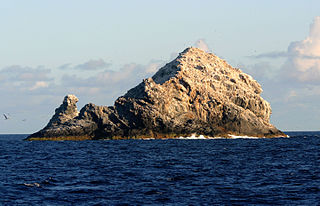
The Gardner Pinnacles are two barren rock outcrops surrounded by a reef and located in the Northwestern Hawaiian Islands.

A lūʻau is a traditional Hawaiian party or feast that is usually accompanied by entertainment. It often features Native Hawaiian cuisine with foods such as poi, kālua puaʻa, poke, lomi salmon, lomi oio, ʻopihi, and haupia, and accompanied with beer and entertainment such as traditional Hawaiian music, kanikapila, and hula. Among people from Hawaiʻi, the concepts of "lūʻau" and "party" are often blended, resulting in graduation lūʻau, wedding lūʻau, baby lūʻau, and birthday lūʻau.

The Makahiki season is the ancient Hawaiian New Year festival, in honor of the god Lono of the Hawaiian religion.

Alyxia stellata, known as maile in Hawaiian, is a species of flowering plant in the dogbane family, Apocynaceae, that is native to Hawaii. It grows as either a twining liana, scandent shrub, or small erect shrub, and is one of the few vines that are endemic to the islands. The leaves are usually ternate, sometimes opposite, and can show both types on the same stem. Flowers are quite inconspicuous and have a sweet and light fragrance of honey. The bark is most fragrant and exudes a slightly sticky, milky sap when punctured, characteristic of the family Apocynaceae. The entire plant contains coumarin, a sweet-smelling compound that is also present in vanilla grass, woodruff and mullein. Fruit are oval and dark purple when ripe. Maile is a morphologically variable plant and the Hawaiian names reflect this.

The cuisine of Hawaii incorporates five distinct styles of food, reflecting the diverse food history of settlement and immigration in the Hawaiian Islands.[a]

Metrosideros polymorpha, the ʻōhiʻa lehua, is a species of flowering evergreen tree in the myrtle family, Myrtaceae, that is endemic to the six largest islands of Hawaiʻi. It is a member of the diverse Metrosideros genus, which are widespread over the southwest Pacific. It is the state tree of Hawai‘i.
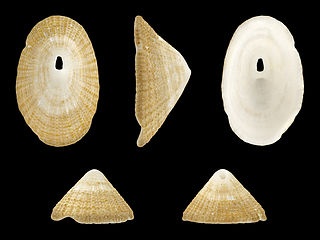
Diodora cayenensis, the Cayenne keyhole limpet, is a species of small to medium-sized sea snail or limpet, a western Atlantic marine prosobranch gastropod mollusk in the family Fissurellidae, the keyhole limpets.

Cellana is a genus of sea snails or limpets, marine gastropod molluscs in the family Nacellidae, the true limpets.
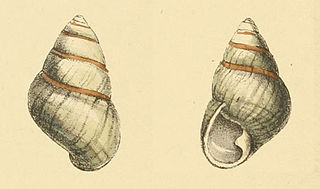
Achatinella livida is a critically endangered species of air-breathing land snail in the family Achatinellidae. This species is endemic to Oʻahu, Hawaiʻi.

Cellana sandwicensis, common name the yellow-foot ʻopihi, is a species of edible true limpet, a marine gastropod mollusc in the family Nacellidae, one of the families of true limpets.

Cellana exarata, common name the black-foot ʻopihi and Hawaiian blackfoot is a species of edible true limpet, a marine gastropod mollusc in the family Nacellidae, one of the families of true limpets. ‘Opihi are significant in Hawaiian history where they have had many uses such as food, tools, and jewelry. They are known as a "fish of death".

Nototrichium is a genus of flowering plants in the family Amaranthaceae. All members of the genus are endemic to the Hawaiian Islands. They are known in Hawaiian as kuluʻī.

The saddle wrasse, also known as Hīnālea Lauwili in Hawaiʻi, is a species of wrasse native to the waters around the Hawaiian Islands and Johnston Island. They are found on reefs at depths from 5 to 25 m. This species can reach 28 cm (11 in) in total length. This species can also be found in the aquarium trade.
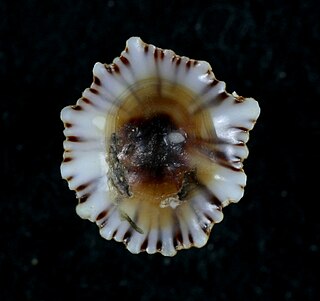
The False 'Opihi or False limpet otherwise known as Siphonaria normalis is an air breathing sea snail that shares its appearance with true limpets. 'Opihi means limpet in Hawaiian. They are part of the Order of Siphonariidae which are known as false limpets. They live in the mid to upper rocky intertidal zone along the coastlines and can be found throughout the Indo-Pacific regions.

Native Hawaiian cuisine refers to the traditional Hawaiian foods that predate contact with Europeans and immigration from East and Southeast Asia. The cuisine consisted of a mix of indigenous plants and animals as well as plants and animals introduced by Polynesian voyagers, who became the Native Hawaiians.
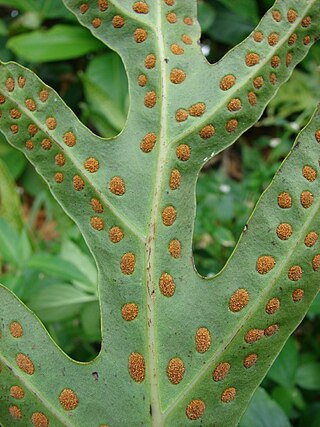
Microsorum scolopendria, synonym Phymatosorus scolopendria, commonly called monarch fern, musk fern, maile-scented fern, breadfruit fern, or wart fern is a species of fern within the family Polypodiaceae. This fern grows in the wild in the Western Pacific rim from Australia to New Caledonia to Fiji and throughout the South Pacific to French Polynesia.

Halulu Lake is a lake in the south central region of the island of Niʻihau. It is the largest (non-intermittent) natural lake in the Hawaiian Islands and ranks third in size after Hālaliʻi Lake and Keālia Pond which are intermittent bodies of water.
Esther Takakura Mookini was an American linguist responsible for several widely used Hawaiian-language dictionaries.
Dictyota sandvicensis also called limu 'Alani in Hawaiian, is a species of brown seaweed in the family Dictyotaceae endemic to the Hawaiian Islands.
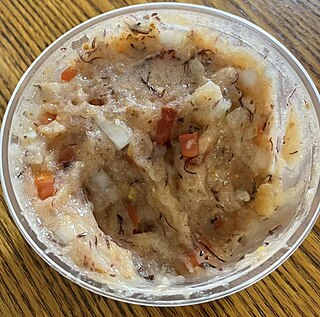
Lomi ʻōʻio is a raw fish dish in traditional Hawaiian cuisine using ʻōʻio (bonefish). This dish is an heirloom recipe fairly unchanged since pre-contact Hawaii, and is a precursor or progenitor to the more well-known but en vogue poke seen today.


















